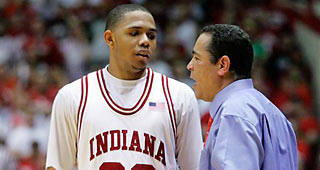At college basketball programs like Kentucky, one-and-done players are the norm. The roster looks dramatically different year-to-year, to the point where the Wildcats feel like a completely new team altogether. John Calipari recruits guys he knows aren’t going to stick around for more than a year, much less four because they are the most talented players in the country.
In the Big Ten over the last five years, it’s been different.
The only program that has dealt with a constant barrage of one-and-done players is Ohio State. The Buckeyes lost Greg Oden, Mike Conley Jr., and Daequan Cook in 2007, then Kosta Koufas in 2008 and finally B.J. Mullins in 2009.
And Jared Sullinger was expected to leave after his stellar freshman campaign last season, but he surprised a lot of people by sticking around. In a year where the looming NBA lockout wasn’t such a deterrent, the decision might have been different, but regardless, he remained in Columbus.
Besides Ohio State, the last major Big Ten one-and-done was Eric Gordon, who left Indiana and was drafted No. 7 overall by the Los Angeles Clippers in 2008.
The conference just doesn’t produce very many players who leave after one season, or even early for that matter.
There have been players who have left early, like Darius Morris, who left Michigan last season after his sophomore year. The other big name that comes to mind is Evan Turner, who left Ohio State in 2010 after his junior year, but I don’t really consider leaving after three years leaving early these days.
All in all, players tend to stick around in the Big Ten.
But it’s not because the conference is bad and the players don’t really have anything better to do than finish their four years, like teams in weaker conferences. Michigan State has made the NCAA Tournament 14 consecutive seasons, and went to the Final Four in 2009 and 2010.
Ohio State lost the national championship game in 2007, and won the NIT in 2008. Programs like Wisconsin, Purdue and Michigan have had off-and-on success in the last decade, but are usually solid.
The Big Ten is no slouch conference, so why have so many talented players stuck around for more than a year or two over the last five years?
Look at a program like Wisconsin, and the answer becomes apparent. It’s not that these players don’t have any talent; it’s that that talent hasn’t been translating to the NBA.
The guys who are succeeding in the Big Ten aren’t going to succeed in the NBA, whether it is because they are system guys or because they don’t match up physically.
Wisconsin runs a very regimented offense that doesn’t require freakish athleticism. It spends as much time as possible working the ball around, not forcing anything, until a Badger gets a wide-open shot with less than seven seconds left on the shot clock. Wisconsin’s style of play isn’t flashy or groundbreaking.
Players like Jon Leuer — solid, rounded out shooters who could pass as dorm RAs (case in point: Mike Bruesewitz) — are the staple of Bo Ryan’s teams. In Leuer’s senior campaign last year, he averaged 18 points per game and finished in the top five in the Big Ten in both scoring and rebounding. He was one of the best players in the conference.
In the 2011 NBA Draft, Leuer fell into the second round before the Milwaukee Bucks picked him No. 40 overall.
Another big example from Wisconsin is senior point guard Jordan Taylor, who is finishing up a career that named him a preseason First Team All-American and a finalist for the Bob Cousy Award.
Taylor is not expected to hear his name called in the draft next year. His lateral speed is average at best, and he is going to have trouble defending quicker players at the next level.
Taylor is one of the best players in the Big Ten, if not the whole country, but his chances of NBA success are limited.
Even at a program like Michigan State, where the NCAA tournament is the standard, guys stick around. Kalin Lucas — who graduated last season — was the Big Ten Player of the Year in his sophomore season.
He is now playing for Olympiacos in the Greek League.
The Big Ten has talent — that’s not a question. The league just doesn’t have talent that appears early (Turner), or talent that fits a college system but doesn’t covert to the next level (Lucas and Taylor).
But the tide could be turning. Michigan just landed the No. 2 recruit in the country, Mitch McGary, who is a one-and-done candidate. Tim Hardaway Jr. could leave for the 2012 NBA Draft after finishing just two-year in Ann Arbor, and freshman point guard Trey Burke might not be far behind him.
At Ohio State, Sullinger will almost certainly leave after his sophomore campaign. Michigan State commit Gary Harris is ranked as the No. 1 shooting guard on some sites, and could be in the 2013 NBA Draft.
The Big Ten will never have a team like Kentucky, but the number of one-and-done players, or guys who leave after two years, is going to jump in the next couple of years.
But in an age of jumping ship, it’s interesting to see how the conference has been able to buck that trend.


